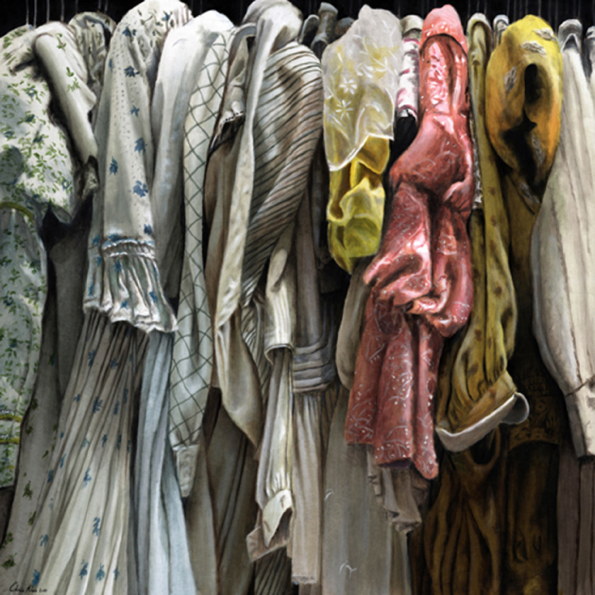
If doubts persist as to the value of “the hand-made†in contemporary art, as opposed to visual sleight of technology, for example, the double exhibition at Galerie Luz helps to further allay them.
Well-known painter Chris Klein, British by birth but currently sharing his time between Quebec and Ontario, presents a series of canvases depicting theatre costumes hanging in a wardrobe. They appear to be the regalia of the Shakespearean variety, and indeed Klein, who is also a scenic artist for film and theatre, is presently serving as the head of scenic art at the Stratford Shakespeare Festival of Canada in Ontario.
Klein’s reverence for both theatre and painting is clearly evident in these beautiful works. I found myself drawn in particular to those that were almost flooded with light by an external source of illumination: the garments, while inert and still, emanated some kind of potentiality. I liked to think that this glow reflected the energy and life of the wearers that had sweat and moved and spoke in them in the past, and also the anticipation of future bodies and future performances. Klein’s work certainly gives the term “still life†an added dimension.
In a peculiar redoubling of history, these paintings are the result of a very current engagement with the traditional medium of the theatre and its production. To paint in oil, moreover, is to dialogue with traditional (western) art practices as well. Presented in series, the works form a poetics of observation as a repeated and prolonged meditation on these beautiful fabrics, folds, pleats and colours.
In Gallery II, the almost-unbelievable drawings of Meredith Cape / Mierte await. At first unsure of what I was looking at, let alone how they might have been done, I was lucky to speak to the artist in person, which both cleared things up and heightened the intrigue. The drawings are entirely in black ink, done with pens of varying thickness. Every line of course done by hand, each picture (in particular the two large ones, I am assuming), took several months to complete. This may be partly the reason why Cape doesn’t remember how each one starts, but it is also commensurate with the highly organic effect of these images. The artist remarked that she wanted to try to cover the whole space, to fill it up. This is a deceptively simple statement because her works are highly intricate, dense, and dynamic. They are also not comprised of merely random forms and shapes: they develop and entwine a complex and personal language of symbols and elements of the natural and the man-made world, neither necessarily overwhelming the other. For example, the artist pointed out a stream of lacy organic shapes on the large work on the far wall: rocks in Georgian Bay. They in turn became the bank of a Medusa-like current of thick plaits of rope, a motif that repeats in various forms throughout her drawing.
If things like geological formations are summoned, looking closely at Cape’s work also gives the sense of life under a microscope—maybe tissues and fibres of flesh, striations of muscle, agglomerations of lipids. Through a dynamic of the lines’ varying densities and thicknesses a surprising depth is created too.
These presentations, which run until July 27, join Nathalie Savoie’s exhibition of small works on vellum, which occupies the (appropriately) small space in the rear of the gallery. All offerings are well worth the visit.
Galerie Luz, space 418
Chris Klein, Meredith Cape/Mierte, Nathalie Savoie
July 3 – 27, 2013
www.galerieluz.com


